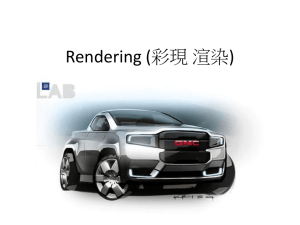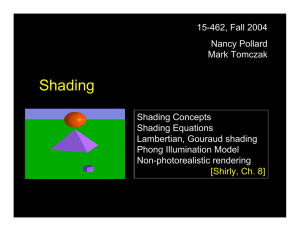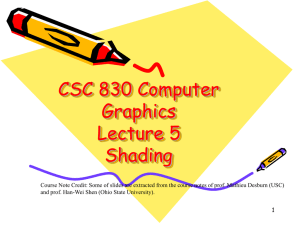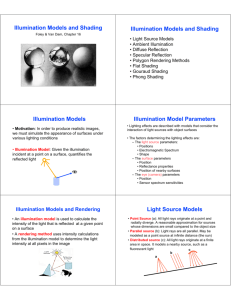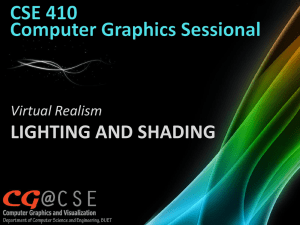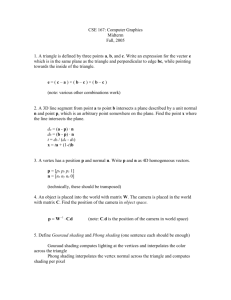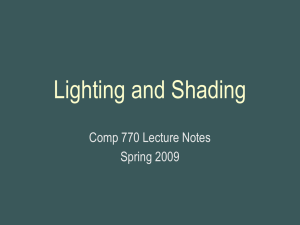Lecture 6: Lighting and Shading Tamar Shinar Computer Science
advertisement
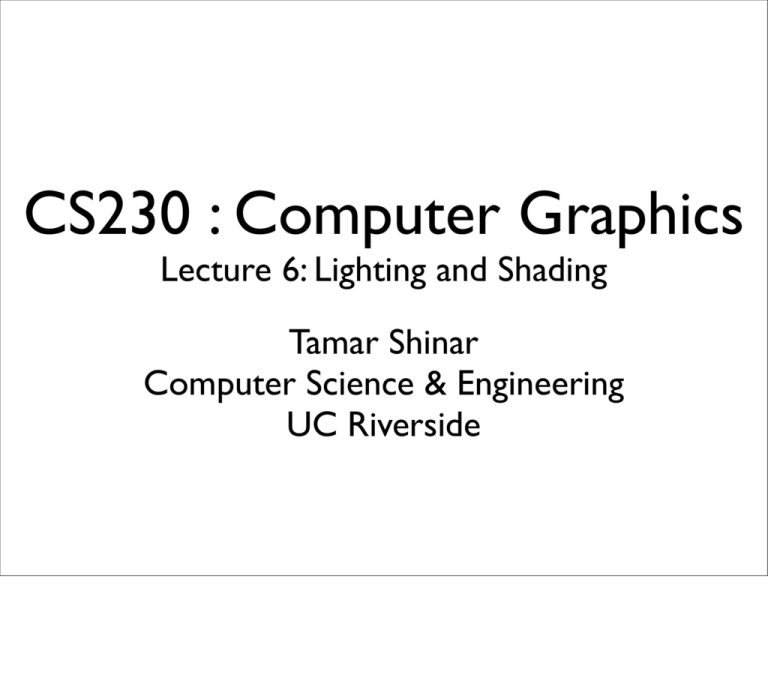
CS230 : Computer Graphics
Lecture 6: Lighting and Shading
Tamar Shinar
Computer Science & Engineering
UC Riverside
Notes
•
•
•
HBC, Chapter 17
Angel, Chapter 5
some slides courtesy of V. Zordan
Why we need shading
•Suppose we build a model of a sphere
using many polygons and color each the
same color. We get something like
•But we want
3
The more realistically lit sphere has gradations in its color that give us a sense of its threedimensionality
Shading
•Why does the image of a real sphere look like
•Light-material interactions cause each point to
have a different color or shade
•Need to consider
- Light sources
- Material properties
- Location of viewer
- Surface orientation (normal)
4
We are going to develop a local lighting model by which we can shade a point independently of the other surfaces in the scene
our goal is to add this to a fast graphics pipeline architecture
General rendering
•
The most general approach is based on
physics - using principles such as
conservation of energy
•
a surface either emits light (e.g., light
bulb) or reflects light for other
illumination sources, or both
•
light interaction with materials is
recursive
•
the rendering equation is an integral
equation describing the limit of this
recursive process
http://en.wikipedia.org/wiki/Rendering_equation
Angel and Shreiner
Fast local shading models
•
•
•
the rendering equation can’t be solved analytically
•
use Phong reflection model
numerical methods aren’t fast enough for real-time
for our fast graphics rendering pipeline, we’ll use a local
model where shade at a point is independent of other
surfaces
•
shading based on local light-material interactions
some approximations to the rendering equation include radiosity and ray tracing, but they
are still not as fast as the local model in the pipeline architecture
Local shading model
direct
light
reflected
light
direct light is the color of the light source
reflected light is the color of the light light reflected from the object surface
for rendering, color of light source and reflected light determines the colors of pixels in the
frame buffer
only need to consider the rays that leave the source and reach the viewers eye
Global Effects
shadow
multiple reflection
translucent surface
8
Light-material interactions
at a surface, light is absorbed, reflected, or transmitted
specular
diffuse
translucent
specular: shiny, smooth surface. light scattered in narrow range close to angle of reflection
e.g., mirror is perfectly specular
diffuse: matte, rough surface. light scattered in all directions
translucent: allows some light to pass through object. refraction: e.g., glass or water
General light source
Illumination function:
integrate contributions from
all sources to shade the point
\vec{x} = (x,y,z)
\vec{omega} = theta, phi
Idealized light sources
•
•
•
•
Ambient light
Point light
Spotlight
distant (directional) light
luminance:
source will be described through three component intensity or luminance
decompose into red, green, blue channels
e.g., use the red component of source to calculate red component of image
use a single scalar equations - each equation applied independently to each channel
Ambient light source
•
achieve a uniform light
level
•
•
no black shadows
ambient light intensity
at each point in the
scene
use scalar I_a to denote any component of \vec{I}_a
ambient light is the same everywhere
but different surfaces will reflect it differently
Point light source
illumination intensity at p:
-
use scalar I(\vec{p}_0) to denote any of three components
points sources alone aren’t too realistic looking -- tend to be high contrast
most real-world scenes have large light sources
add ambient light to mitigate high contrast
Point light source
Most real-world scenes
have large light sources
Point light sources alone aren’t too realistic
- add ambient light to mitigate high
contrast
- umbra is fully in shadow, penumbra is partially in shadow
Point light source
Most real-world scenes
have large light sources
Point light sources alone aren’t too realistic
- drop off intensity more slowly
In practice, we also replace the 1/d^2 term by something that falls off more slowly
Spotlights
Intensity
Spotlights
Intensity
add an exponent for greater control
final result is like point light but modified by this cone
Distant light source
characterized
by direction
most shading calculations require direction from the surface point to the light source position
if the light source is very far, the direction vectors don’t change
e.g., sun
characterized by direction rather than position
Phong Reflection Model
Brad Smith, Wikimedia Commons
•efficient, reasonably realistic
•3 components
•4 vectors
-
l to light source
n surface normal
v to viewer
r perfect reflector (function of n and l)
Phong Reflection Model
Brad Smith, Wikimedia Commons
for each light source and each color channel:
color intensity
illumination
reflectance
Ambient reflection
different ambient
coefficients for
different colors
ambient
reflection
coefficient
e.g., white light shining on the object will be reflected differently in red, green, blue channels
e.g., more red and blue reflection here
Diffuse reflection
http://emmybella.wordpress.com/the-laws-of-reflection/
e.g., paper, unfinished wood, unpolished stone
Diffuse reflection
Lambert’s cosine law
diffuse
reflection
coefficient
direct: maximum
light intensity
indirect: reduced
light intensity
- the light is reduced by cos of angle
- this is because same amount of light is spread over larger area when light comes in at an
angle
Specular reflection
Ideal reflector:
•angle of incidence=
angle of reflection
•viewer position matters
e.g., white light shining on the object will be reflected differently in red, green, blue channels
e.g., more red and blue reflection here
Specular reflection
Specular surface:
specular
highlight
specular reflection is strongest in mirror reflection direction
area of specular highlight depends on how smooth the surface is
Specular reflection
specular
reflection
coefficient
shininess
coefficient
specular reflection is strongest in mirror reflection direction
drops off with increasing angle
Phong proposed this model
Specular reflection
plastic
metal
Phong proposed this model
clamp to 0 -- avoid negative values
the fuzzy highlight was too big without an exponent
shininess
coefficient
Phong Reflection Model
Brad Smith, Wikimedia Commons
Phong Reflection Model
Brad Smith, Wikimedia Commons
Alternative: Blinn-Phong Model
halfway vector
h
replace v.r with h.n
this way we donʼt have to recompute r, which depends on n
h does not depend on n
saves a lot especially for directional lights and constant viewing direction
p
10: eggshell
100: shiny
1000: glossy
10000: mirror-like
Shading Polygonal Geomtery
Constant (“Flat”) Shading
•
•
•
Simplest approach
apply illumination model once for each polygon
valid when:
•
•
•
light source at
viewer at
object is actually faceted
If light source or viewer is not at infty, need heuristic for picking color - e.g., first vertex, or
polygon center
- does not produce variations in gradation
Mach Band Effect
This effect makes flat shading seem even worse
Shading Polygons
•Polygons often approximate curve surfaces but
are inherently flat
•Consider polygonal ‘sphere’
•Want to smooth the rough
face of each surface facet
•How do we fix this?
35
even if we applied the lighting model at each pixel, we would still get faceted appearance
Smooth Shading
•We can simply find a new
normal at each vertex for
a sphere
•Easy for sphere model
-If centered at origin n = p
•Results in smoother
shading
•Note silhouette edge
36
Vertex Normals
•The sphere example is not general
because we knew the normal at each
vertex analytically
•For polygonal meshes, Gouraud 1971
proposed we use the average of normals
around a mesh vertex
37
Interpolating Normals
• Must renormalize
38
Interpolating Normals
• Must renormalize
39
Interpolating Normals
• Must renormalize
40
Gouraud Smoothing
-AKA: intensity interpolation shading
-Used in OpenGL
-Find vertex normals
-Apply Phong light model at each vertex
-Interpolate vertex shades across each polygon
41
Phong Smoothing
- Not the Phong lighting
model!
-AKA: normal-vector
interpolation shading
-Find vertex normals
-Interpolate vertex normals
across edges and then
across polygon
-Find shades using normals
across polygons
Wikimedia Commons
42
interpolate normals and make an independent shading calculation
Note: Phong shading requires that the lighting model be applied to each fragment - hence, per-fragment shading
Comparison
Flat
-
Gouraud
Phong
Phong interpolation looks smoother -- can see edges on the Gouraud model
but Phong is a lot more work
both Phong and Gouraud require vertex normals
both Phong and Gouraud leave silhouettes
Comparison
•If the polygon mesh approximates surfaces with a
high curvatures, Phong smoothing may look
smooth when Gouraud shows edges
•Phong smoothing requires much more work than
Gouraud smoothing
•Both need data structures to represent meshes
so we can obtain vertex normals
•Both leave the silhouette jagged
44
Problems with Interpolated
Shading
•
•
•
•
Polygonal silhouette
Perspective distortion
Orientation dependence
Unrepresentative surface normals
Foley, van Dam, Feiner, Hughes
Foley, van Dam, Feiner, Hughes
Shading and Lighting in
OpenGL
Material/Shading
•A simple model that can be computed rapidly
•Includes three components
-Diffuse
-Specular
-Ambient
•Uses four vectors
-To source, I
-To viewer, v
-Normal, n
-Perfect reflector, r
47
Steps in OpenGL shading
1. Enable shading and select model
2. Specify lights
3. Specify material properties
4. Specify normals
48
Enabling Shading
•Shading calculations are enabled by
-glEnable(GL_LIGHTING)
-Once lighting is enabled, glColor() ignored
•Polygon shading is turned on as:
-glShadeModel(GL_SMOOTH) or
-glShadeModel(GL_FLAT)
•Must enable light sources individually
-glEnable(GL_LIGHTi)
i=0,1…..
•Choose lighting parameters
49
Defining a Light Source
•For each light source, we can set an RGB for the
diffuse, specular, and ambient parts, and the
position
GLfloat diffuse0[]={1.0, 0.0, 0.0, 1.0};
GLfloat ambient0[]={1.0, 0.0, 0.0, 1.0};
GLfloat specular0[]={1.0, 0.0, 0.0, 1.0};
GLfloat light0_pos[]={1.0, 2.0, 3,0, 1.0};
glEnable(GL_LIGHTING);
glEnable(GL_LIGHT0);
glLightv(GL_LIGHT0, GL_POSITION, light0_pos);
glLightv(GL_LIGHT0, GL_AMBIENT, ambient0);
glLightv(GL_LIGHT0, GL_DIFFUSE, diffuse0);
glLightv(GL_LIGHT0, GL_SPECULAR, specular0);
50
Material Properties
•Material properties are also part of the OpenGL
state and match the terms in the Phong model
• Set by glMaterialv()
GLfloat ambient[] = {0.2, 0.2, 0.2, 1.0};
GLfloat diffuse[] = {1.0, 0.8, 0.0, 1.0};
GLfloat specular[] = {1.0, 1.0, 1.0, 1.0};
glMaterialf(GL_FRONT, GL_AMBIENT, ambient);
glMaterialf(GL_FRONT, GL_DIFFUSE, diffuse);
glMaterialf(GL_FRONT, GL_SPECULAR, specular);
51
